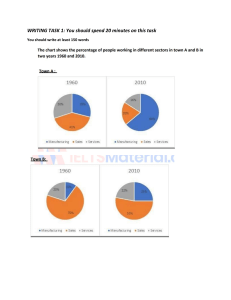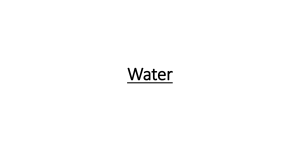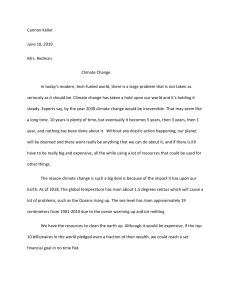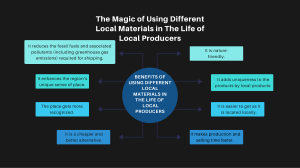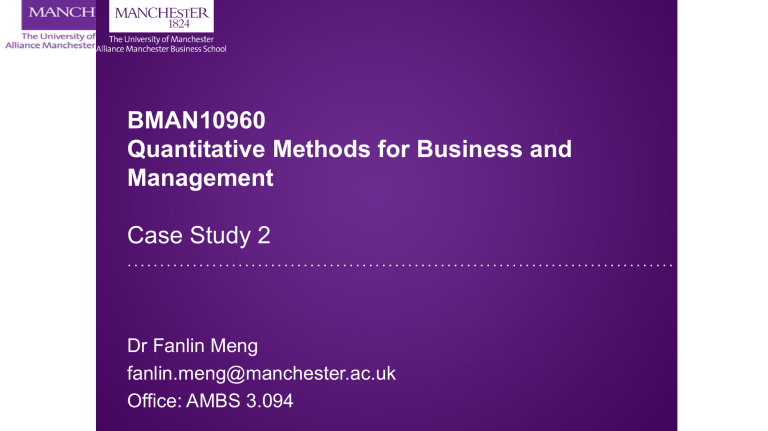
BMAN10960 Quantitative Methods for Business and Management Case Study 2 Dr Fanlin Meng fanlin.meng@manchester.ac.uk Office: AMBS 3.094 Problem description Brief: SteelUK is a major steel producer in Northern England. The new CEO wants to implement a Social Responsibility policy by committing SteelUK to reducing its annual emission of pollutants (see Table 1). The company will invest in upgrading its technology regarding two aspects: better filters and better fuels. The financial team has evaluated the annual cost of the investment in relation to the percentage of filters and fuels upgraded to new technologies (Table 2). In particular, there is a basic (upkeep) cost that must be paid independently of the upgrade and an additional cost that depends on the percentage of upgrade. For example, if 10% of filters and 50% of fuels are upgraded, the total annual cost will be 0.15 · 10 + 2 + 0.05 · 50 + 9. In addition, the engineering team has provided you with data estimating the reduction of pollutants as a factor of the percentage of upgrade (Table 3). For example, if 10% of filters and 50% of fuels are upgraded, the reduction in PM will be 0.3 · 10 + 0.09 · 50 = 7.5 tons ×1000, which is not enough to reach the target reduction for PM of 10 tons ×1000 (Table 1). The company has hired you to find out the percentage of its filters and fuels that must be upgraded in order to achieve at least the target reduction (Table 1) for all pollutants while minimising the total annual cost. BMAN10960 Case Study 2 2 Problem description Brief: SteelUK is a major steel producer in Northern England. The new CEO wants to implement a Social Responsibility policy by committing SteelUK to reducing its annual emission of pollutants (see Table 1). BMAN10960 Case Study 2 3 Problem description The company will invest in upgrading its technology regarding two aspects: better filters and better fuels. The financial team has evaluated the annual cost of the investment in relation to the percentage of filters and fuels upgraded to new technologies (Table 2). In particular, there is a basic (upkeep) cost that must be paid independently of the upgrade and an additional cost that depends on the percentage of upgrade. For example, if 10% of filters and 50% of fuels are upgraded, the total annual cost will be 0.15 · 10 + 2 + 0.05 · 50 + 9. BMAN10960 Case Study 2 4 Problem description In addition, the engineering team has provided you with data estimating the reduction of pollutants as a factor of the percentage of upgrade (Table 3). For example, if 10% of filters and 50% of fuels are upgraded, the reduction in PM will be 0.3 · 10 + 0.09 · 50 = 7.5 tons ×1000, which is not enough to reach the target reduction for PM of 10 tons ×1000 (Table 1). BMAN10960 Case Study 2 5 Problem description Brief: SteelUK is a major steel producer in Northern England. The new CEO wants to implement a Social Responsibility policy by committing SteelUK to reducing its annual emission of pollutants (see Table 1). The company will invest in upgrading its technology regarding two aspects: better filters and better fuels. The financial team has evaluated the annual cost of the investment in relation to the percentage of filters and fuels upgraded to new technologies (Table 2). In particular, there is a basic (upkeep) cost that must be paid independently of the upgrade and an additional cost that depends on the percentage of upgrade. For example, if 10% of filters and 50% of fuels are upgraded, the total annual cost will be 0.15 · 10 + 2 + 0.05 · 50 + 9. In addition, the engineering team has provided you with data estimating the reduction of pollutants as a factor of the percentage of upgrade (Table 3). For example, if 10% of filters and 50% of fuels are upgraded, the reduction in PM will be 0.3 · 10 + 0.09 · 50 = 7.5 tons ×1000, which is not enough to reach the target reduction for PM of 10 tons ×1000 (Table 1). percentage of its filters and fuels that must be upgraded in order to achieve at least the target reduction (Table 1) for all pollutants while minimising the total annual cost. The company has hired you to find out the BMAN10960 Case Study 2 6 Q1 Question 1: Using the data in Tables 1, 2 and 3, formulate the problem as a linear programming (LP) model. Label clearly the objective, constraints and decision variables. Decision variables 𝑥1 = % 𝑢𝑝𝑔𝑟𝑎𝑑𝑒 𝑓𝑖𝑙𝑡𝑒𝑟𝑠 𝑥2 = % 𝑢𝑝𝑔𝑟𝑎𝑑𝑒 𝑓𝑢𝑒𝑙𝑠 Objective function 𝑀𝑖𝑛 𝑧 = 0.15𝑥1 + 0.05𝑥2 + 2 + 9 Constraints 𝑃𝑀: 0.3𝑥1 + 0.09𝑥2 ≥ 10 𝑆02 : 0.4𝑥1 + 0.01𝑥2 ≥ 34 𝐶𝑂: 0.2𝑥1 + 0.5𝑥2 ≥ 50 𝑥1 , 𝑥2 ≥ 0 𝑥1 , 𝑥2 ≤ 100 BMAN10960 Case Study 2 7 Q2 Question 2: Solve the LP problem from Question 1 graphically and using Excel solver, respectively. For the graphical solution, draw a coordinate system with all the constraints, indicate where the feasible region is, and draw the objective function going through the optimal solution. Provide the coordinates of the optimal solution (approximately). Compare your graphical solution with the solution obtained from Excel Solver. BMAN10960 Case Study 2 8 Q2 Graphical Solution Constraints: 𝑃𝑀: 0.3𝑥1 + 0.09𝑥2 ≥ 10; 𝑆02 : 0.4𝑥1 + 0.01𝑥2 ≥ 34; 𝐶𝑂: 0.2𝑥1 + 0.5𝑥2 ≥ 50 𝑥1 , 𝑥2 ≥ 0; 𝑥1 , 𝑥2 ≤ 100 Feasible Region BMAN10960 Case Study 2 9 Q2 Graphical Solution Objective function: 𝑀𝑖𝑛 𝑧 = 0.15𝑥1 + 0.05𝑥2 + 2 + 9 BMAN10960 Case Study 2 𝒙𝟏 ≈ 𝟖𝟔 𝒙𝟐 ≈ 𝟔𝟔 10 Q3 Question 3: Two other types of technologies are also considered for upgrade: Furnaces and smokestacks. Data regarding the financial cost and pollution reduction is given in Table 4 as a linear factor (i.e., the slope of the linear function) of the percentage of upgrade. Extend the Linear Programming (LP) model from Q2 to include these two additional decision variables. Note that the inclusion of these two decision variables will require you to modify both the objective and the constraints. Solve the resulting LP problem by means of the Solver tool in Excel. What is the percentage of filters, fuels, furnaces and smokestacks that should be upgraded to the new technologies? Compare your results to Q2 and analyse the reason(s) for a potential shift in the optimal solution (compared to Q2). BMAN10960 Case Study 2 11 Q3 BMAN10960 Case Study 2 12 Q3 Decision variables 𝑥1 = % 𝑢𝑝𝑔𝑟𝑎𝑑𝑒 𝑓𝑖𝑙𝑡𝑒𝑟𝑠 𝑥2 = % 𝑢𝑝𝑔𝑟𝑎𝑑𝑒 𝑓𝑢𝑒𝑙𝑠 𝒙𝟑 = % 𝒖𝒑𝒈𝒓𝒂𝒅𝒆 𝑭𝒖𝒓𝒏𝒂𝒄𝒆𝒔 𝒙𝟒 = % 𝒖𝒑𝒈𝒓𝒂𝒅𝒆 𝑺𝒎𝒐𝒌𝒆𝒔𝒕𝒂𝒄𝒌𝒔 Objective function 𝑀𝑖𝑛 𝑧 = 0.15𝑥1 + 0.05𝑥2 + 𝟎. 𝟏𝒙𝟑 + 𝟎. 𝟎𝟓𝒙𝟒 + 2 + 9 Constraints 𝑃𝑀: 0.3𝑥1 + 0.09𝑥2 + 𝟎. 𝟎𝒙𝟑 + 𝟎. 𝟐𝒙𝟒 ≥ 10 𝑆02 : 0.4𝑥1 + 0.01𝑥2 + 𝟎. 𝟎𝟑𝒙𝟑 + 𝟎. 𝟏𝟓𝒙𝟒 ≥ 34 𝐶𝑂: 0.2𝑥1 + 0.5𝑥2 + 𝟎. 𝟏𝟓𝒙𝟑 + 𝟎. 𝟎𝟖𝒙𝟒 ≥ 50 𝑥1 , 𝑥2 , 𝒙𝟑 , 𝒙𝟒 ≥ 0 𝑥1 , 𝑥2 , 𝒙𝟑 , 𝒙𝟒 ≤ 100 BMAN10960 Case Study 2 13
